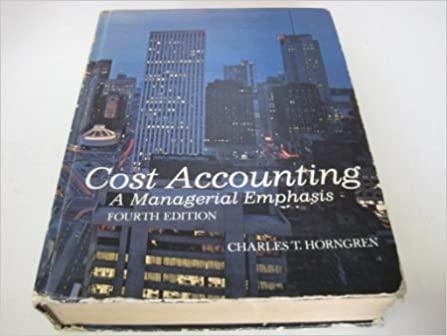Soviet Approach to Return on Investment The Soviet System is a management control and evaluation system (bonus
Question:
Soviet Approach to Return on Investment ‘The Soviet System is a management control and evaluation system (bonus system) that is used in much of the Soviet economy. It is used to evaluate managers and determine their bonuses,
and thus (it is hoped) to motivate the individual managers to cut costs and work toward the country’s goals as specified by the central planning agency.
One of these goals is to modernize the country’s production facilities. The stated purpose was to increase the material interest of the management and employees in the economic results of the enterprise. The new management control system was a part of sweeping economy reforms that took effect in January 1966. As stated in Bertrand Horwitz, Accounting Controls and the Soviet Econome Reforms of 1966 (Sarasota, Fla.: American Accounting Association, WO), Jo. ABs Prior to January 1966, when the reforms first took effect, the director of a Soviet enterprise was confronted with the requirement of satisfying numerous physical and accounting goals. The enterprise was essentially a cell in a tautly administered system which allowed the director little room for independent action because the number of physical and accounting indexes by which he could be judged highly constrained his economic actions.
The new bonus system was based on the enterprise’s increase in profits and the rate of return on assets employed in the enterprise. The exact formula used to compute the total bonuses to be distributed to the enterprise’s employees is as follows:
(Pi goat! ai oar (1) A, =a and the total amount of the bonus for the enterprise is:
(2) TB, = WA, where W, = the wage fund for time period ¢, centrally determined P, = profit in period ¢ that is net of explicit charges for the use of current and fixed gross assets at original cost 7B, = total amount of enterprise bonus for period ¢
K, = total average gross assets in ¢ at original cost
a, 8 = coefficients that are centrally assigned norms; both are less than one and are nonnegative |
The first term of equation (1) is the rate of increase in earnings over the previous year. The second term is the ROI for the enterprise based on its gross assets. The sum of these two terms gives a factor (A,) that, when multiplied by the enterprise’s wage fund, determines the total bonus for the enterprise. Thus, the total bonus for the enterprise depends on the enterprise’s increase in profit over the previous year and its ROI.
The wage fund (W,) for the enterprise in a period is centrally determined and therefore is a given amount for purposes of computation of the bonus. The accounting profit (P,) is the enterprise’s net profit before capital charges, minus
(a) charges at the rate of 6 percent of gross assets, for the use of fixed assets and normal or planned working capital;
(b) fixed (rent) payments; and
(c) interest on bank credit. The charge of 6 percent is essentially the enterprise’s cost of capital, because the enterprise gets its fixed assets from the government. The charge is also based on gross assets. The rent payments are designed to eliminate the differences between different enterprises because of natural operating conditions. Thus, a firm with very favorable conditions would have to make rent payments, while one operating under less favorable conditions would not. The interest is for short-term loans from the central bank.
Average gross assets (K,,) is used as the investment base in order to motivate managers to replace their older, less efficient assets. The purpose is to get managers to modernize their equipment.
The coefficients a and £ are centrally assigned and are set so that the resulting bonuses will be reasonable in light of the enterprise’s operating conditions. This is essentially another way of equalizing the natural operating conditions of the various enterprises in the economy.
Assume that the enterprise did not have to make any rent payments and had no short-term loans from the central bank. Suppose the enterprise had the following profit (after deductions), gross assets, and wage fund, in thousands of rubles:
P, = 3,000 K, = 20,000 P,_, = 2,800 W,= 4,000 Also, suppose that the central planners had assigned the firm an a = .5 and B = .25.
. Compute the total bonus.
. Compare the probable motivational effects of the Soviet method with those of ROI and residual income.
Step by Step Answer:






